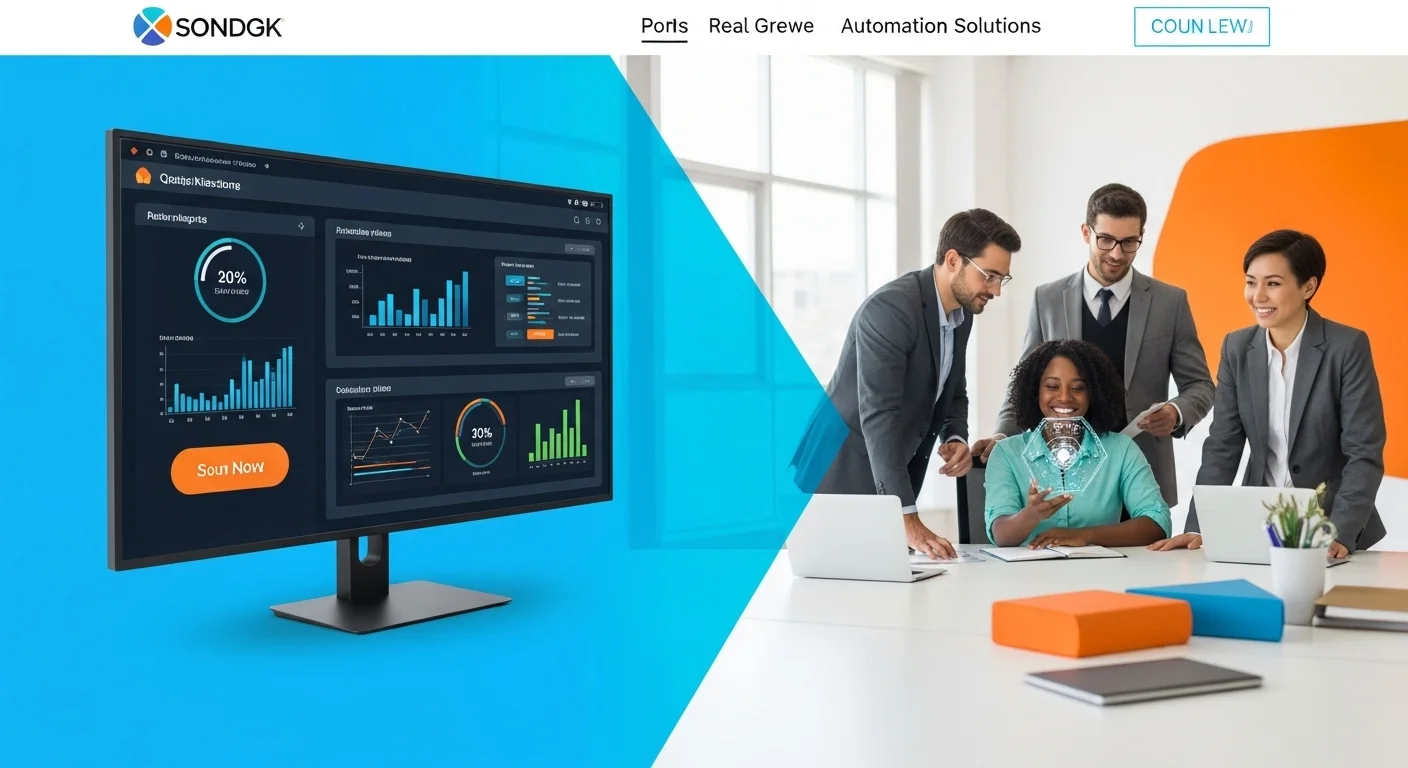Unlocking Efficiency: Your Practical Guide to Automation Solutions

Executive Summary
In my years as a strategist, I've seen one thing consistently: we're all looking for ways to get more done with less effort. That’s the simple promise of automation. It’s not about futuristic robots taking over; it’s about using smart technology to handle the repetitive, time-consuming tasks that bog down our work and our lives. This guide is my attempt to demystify automation. We'll explore how businesses can use it to become incredibly efficient and how you can bring that same power into your own home to create a more convenient and intelligent living space. From simple process tweaks to fully integrated smart homes, I'll provide clear insights and real-world examples to help you harness the true potential of automation.
Table of Contents
In This Guide:
What Are Automation Solutions, Really?
I remember the first time I saw true automation in action at a client's office. They were drowning in paperwork, manually processing thousands of invoices a month. It was slow, costly, and full of errors. We brought in a system that did it all automatically. The change was like night and day. That’s the essence of automation solutions: using technology to perform tasks that would otherwise require human intervention. At its heart, it’s about creating a system—whether with software, AI, or smart devices—that follows a set of rules to get a job done efficiently.
In the business world, we often talk about Business Process Automation (BPA). This is about looking at a whole workflow, like that invoicing nightmare, and streamlining it from start to finish. It’s about making operations faster, more accurate, and cheaper. By letting technology handle the grunt work, you free up your team for what they do best: thinking critically, being creative, and solving complex problems. It's a massive boost for productivity and, honestly, for morale. No one enjoys mind-numbing, repetitive work.
This same principle applies right inside our own homes. Think about home automation solutions. They aren't just gadgets; they're about creating convenience and efficiency in your personal life. It's the same logic: automate the routine tasks. This can be as simple as having your lights turn on automatically as you arrive home or as advanced as an integrated system managing your climate, security, and entertainment.
These smart home automation solutions connect devices like thermostats, locks, cameras, and speakers into a single network you can control from your phone or with your voice. The goal is to make your home more comfortable, secure, and energy-efficient. A smart thermostat learns your schedule to save on heating bills, and an automated security camera gives you peace of mind. It’s about making your environment work for you.
When people ask me for the best home automation solution, I always say it depends on your goal. Are you a tinkerer who loves DIY projects? Or do you want something that just works, flawlessly? For those who want the absolute peak experience, we look at complete home automation solutions. These are professionally designed systems where every component is built to work together in perfect harmony. In my experience, the gold standard here is Crestron automation solutions. I’ve seen Crestron systems manage everything in multi-million dollar homes and corporate boardrooms—from lighting and shades to complex audio-visual setups—all from a single, elegant interface. It's the ultimate expression of what automation can be: powerful, reliable, and seamlessly integrated into your life.

Your Complete Guide to Automation in Business and Tech
Whether you're a CEO or a homeowner, diving into automation requires a plan. You need to know the tools, the strategies, and the potential pitfalls. Here’s the playbook I use to help people navigate this world and find the right solutions for their needs.
Understanding the Different Types of Automation
Automation isn't a one-size-fits-all tool. It comes in different flavors, each suited for specific jobs. Understanding them is key.
- Robotic Process Automation (RPA): Think of RPA as a digital assistant that you can teach to do simple, rules-based tasks on a computer. It can log into apps, copy-paste data, fill out forms, and move files—just like a person would, only faster and without mistakes. It's perfect for older systems that don't have modern ways to connect.
- Business Process Automation (BPA): BPA is the big picture. Instead of just automating one task, it automates an entire workflow from start to finish. It connects different systems, people, and data to streamline a whole operation, like onboarding a new employee or processing an insurance claim. It's more involved than RPA but delivers a much bigger impact.
- Intelligent Automation (IA): This is where things get really smart. IA combines automation with Artificial Intelligence (AI). While regular automation follows strict rules, IA can handle messy, unstructured data and make judgments. It can understand human language in an email, 'read' a document, or spot patterns a human might miss. This is the future of automation.
- IT Automation: This is the engine room of modern tech. It's all about using software to manage IT infrastructure—deploying apps, managing servers, and monitoring network health with minimal human effort. It’s what makes cloud computing and fast-paced software development possible.
How to Implement Automation in Your Business
Having the right tech is only half the battle. A successful rollout is all about strategy. Here are the steps I always recommend:
- Start with the Annoying Stuff: Don't try to boil the ocean. Look for the most repetitive, high-volume, error-prone tasks. Automating these first gives you a quick win, proves the value, and builds momentum for bigger projects.
- Fix the Process First: A classic mistake is automating a broken process. All you get is a faster broken process. Take the time to map out your current workflow, find the kinks, and streamline it. Then, and only then, you automate.
- Choose Your Tools Wisely: Your automation platform should match your needs and be able to grow with you. Think about how it will connect with the software you already use. Sometimes, the shiny new tool isn't the best fit.
- Bring Your Team Along: Automation can make people nervous about their jobs. Be transparent. Explain that the goal is to get rid of boring work so they can focus on more valuable, interesting challenges. I've found that when you involve employees in the process, they become your biggest supporters.
- Measure Your Success: Define what success looks like before you start. Is it time saved? Money saved? Fewer errors? Track these metrics to see your return on investment and find your next automation opportunity.
A Real-World Look at Home Automation Solutions
The home automation market is a perfect example of these choices in action.
- The DIY Approach: Using protocols like Zigbee or Z-Wave, you can build a system piece by piece. It's flexible and budget-friendly, but you might end up with a dozen different apps and some compatibility headaches. It's great for hobbyists who enjoy tinkering.
- The Mainstream Ecosystems: Amazon Alexa, Google Assistant, and Apple HomeKit have made smart homes accessible to everyone. They provide a central hub (like a smart speaker) and a single app to control devices from hundreds of brands. For most people, this is the best home automation solution because it balances ease of use with power.
- The Professional-Grade Systems: For the ultimate smart home, you go to the pros. Brands like Crestron, Control4, and Savant offer complete home automation solutions. These systems are not DIY; they are custom-designed and installed for your home. With a Crestron automation solution, you get rock-solid reliability and a single, seamless interface for everything. It's a significant investment, but for those who want the best, it's the only way to go. It’s the home equivalent of a fully integrated enterprise BPA strategy.

Practical Tips for Mastering Automation
Putting automation to work, whether in a global enterprise or your living room, is about more than just technology. It’s about adopting a mindset of continuous improvement. Here are some practical tips I’ve learned over the years to help you get the most out of your automation journey.
Best Practices for Business Automation
- Build a Center of Excellence (CoE): If you're serious about automation, create a dedicated team to lead the charge. This team sets the standards, vets the projects, and champions the cause across the company. It’s the single best way to ensure your automation efforts are strategic and consistent, not chaotic.
- Treat Security as Day One Priority: I can't stress this enough. I've seen promising projects get derailed because security was an afterthought. Your automated systems and software 'bots' are new gateways into your network. Secure them from the start with strong access controls, encryption, and regular audits.
- Focus on Augmentation, Not Replacement: The narrative shouldn't be about replacing people. It's about giving them superpowers. Frame automation as a tool that eliminates drudgery and frees up your team for innovation and high-value work. Invest in training to help them manage and work alongside these new digital colleagues.
- Think Big with Hyperautomation: Don't just automate in pockets. Hyperautomation is about taking a disciplined, organization-wide approach to identify and automate as many processes as possible. It involves using a whole toolbox of technologies—RPA, AI, machine learning—to create a truly agile and efficient organization.
- Choose Platforms That Play Well with Others: Avoid getting stuck with a tool that only does one thing. Look for scalable automation platforms that can integrate with your core business systems (like your CRM and ERP). A unified platform is far easier to manage and gives you a much better view of your operations.
A Real-World Look at Home Automation Solutions
The home automation market is a perfect example of these choices in action.
- The DIY Approach: Using protocols like Zigbee or Z-Wave, you can build a system piece by piece. It's flexible and budget-friendly, but you might end up with a dozen different apps and some compatibility headaches. It's great for hobbyists who enjoy tinkering.
- The Mainstream Ecosystems: Amazon Alexa, Google Assistant, and Apple HomeKit have made smart homes accessible to everyone. They provide a central hub (like a smart speaker) and a single app to control devices from hundreds of brands. For most people, this is the best home automation solution because it balances ease of use with power.
- The Professional-Grade Systems: For the ultimate smart home, you go to the pros. Brands like Crestron, Control4, and Savant offer complete home automation solutions. These systems are not DIY; they are custom-designed and installed for your home. With a Crestron automation solution, you get rock-solid reliability and a single, seamless interface for everything. It's a significant investment, but for those who want the best, it's the only way to go. It’s the home equivalent of a fully integrated enterprise BPA strategy.
For anyone wanting to explore the broader impact of this shift, I highly recommend the 'AI, automation, and the future of work' report by McKinsey. It offers incredible insight into the economic and societal changes we're navigating. By applying these strategies, you can transform your business and your daily life to be more intelligent, efficient, and enjoyable.
Expert Reviews & Testimonials
Sarah Johnson, Business Owner ⭐⭐⭐⭐⭐
As a small business owner, I was intimidated by automation. This article broke it down perfectly. The tip about starting with high-impact, repetitive tasks was a game-changer for us.
Mike Chen, IT Consultant ⭐⭐⭐⭐
Finally, an article that explains the difference between RPA and BPA in a way that makes sense! The analogies were super helpful. Great read for any IT pro.
Emma Davis, Tech Enthusiast ⭐⭐⭐⭐⭐
This guide is fantastic. I especially appreciated the balanced look at home automation, from DIY options to pro systems like Crestron. It helped me map out my own smart home project. Five stars!



